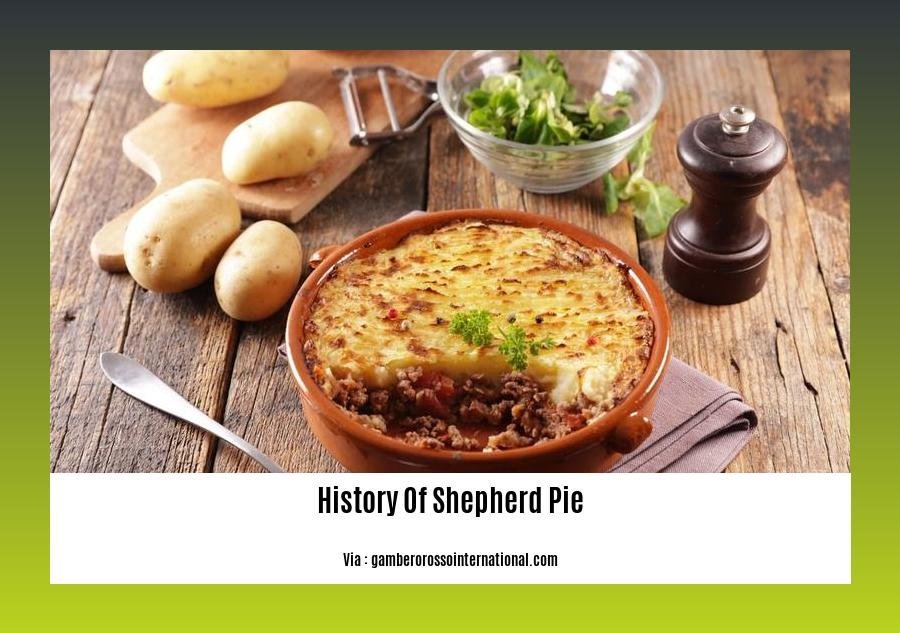Embark on a captivating culinary journey through time as we unveil the rich history of Shepherd’s Pie, a dish that has tantalized taste buds across generations. From its humble origins in the rolling hills of the British countryside to its transformation into a beloved comfort food enjoyed worldwide, discover the fascinating story behind this iconic dish in [A Culinary Journey Through Time: Unveiling the History of Shepherd’s Pie].
Key Takeaways:
Shepherd’s pie is a classic dish with origins in the British Isles, dating back to the 18th century.
It emerged during a time of British and Protestant Irish landowners and Irish Catholic peasant land workers.
The dish gained popularity due to its affordability and ease of preparation, becoming a staple for working-class families.
Traditional shepherd’s pie uses ground lamb or mutton topped with mashed potatoes and is baked in the oven.
The use of potatoes as a topping is linked to their introduction to Ireland in the 16th century, where they became a staple food crop.
Shepherd’s pie has become a beloved dish in many countries, often served as a hearty and comforting meal.
History of Shepherd’s Pie

Embark on a culinary journey through time as we trace the rich history of shepherd’s pie, a dish that has stood the test of time, embodying both the simplicity of humble beginnings and the enduring power of culinary craftsmanship.
Humble Origins
The roots of shepherd’s pie can be traced back to the British Isles, where it originated in the 18th century as a hearty and economical meal for working-class families. The dish likely emerged during a period when the British and Protestant Irish were the ruling landowners while Irish Catholics worked as peasant land workers, often referred to as “shepherds.”
With limited resources and a need for sustenance, these families turned to simple, locally sourced ingredients to create a nourishing dish. Ground lamb or mutton, readily available from the livestock they tended, formed the base of the pie. Topped with a layer of mashed potatoes, a staple food crop introduced to Ireland in the 16th century, shepherd’s pie provided a filling and affordable meal.
Evolution of a Classic
Over time, shepherd’s pie evolved beyond its humble origins, gaining popularity across social classes. The use of ground beef or pork became common, reflecting regional preferences and availability of ingredients. Vegetables like peas, carrots, and onions were often added to enhance flavor and texture, while herbs and spices lent depth to the dish.
Shepherd’s pie made its way to other parts of the world, carried by British settlers and immigrants. In the United States, it became a staple in American cuisine, often referred to as “cottage pie” to distinguish it from the American version made with ground beef. Today, shepherd’s pie is a beloved dish enjoyed in households and restaurants worldwide, a testament to its enduring appeal.
Comfort Food with a Twist
The essence of shepherd’s pie lies in its simplicity and versatility. The combination of savory meat, creamy mashed potatoes, and flavorful vegetables creates a comforting and satisfying dish that appeals to people of all ages.
While traditional shepherd’s pie remains a popular choice, modern variations have emerged, reflecting contemporary culinary trends. Some chefs opt for gourmet twists, using premium cuts of lamb or incorporating unique ingredients like wild mushrooms or artisanal cheeses. Vegetarian and vegan versions have also gained popularity, featuring plant-based alternatives to meat and dairy.
Whether you prefer the classic recipe or a contemporary interpretation, shepherd’s pie continues to captivate taste buds and warm hearts, embodying the enduring power of culinary heritage.
For a comprehensive history of Spanish cuisine, exploring its rich culinary traditions and influences, click here or on the history of Spanish food.
Shepherd’s Pie: A Culinary Tale of Humble Origins to Comfort Food Staple

A Shepherd’s Delight: Humble Roots, Timeless Appeal
Shepherd’s pie, a comforting dish with a rich past, traces its roots to the kitchens of 18th-century Britain. It emerged as a resourceful way for working-class families, particularly in Scotland and northern England, to use leftover roasted meat, often lamb, and elevate it into a hearty and satisfying meal.
The combination of savory minced lamb or mutton topped with a fluffy layer of mashed potatoes, lovingly baked to golden perfection, encapsulated the essence of thrift and culinary innovation. It soon gained popularity among those with limited means, becoming a staple in the homes of the working class.
Evolution of a Classic: From Cottage Pie to Global Favorite
Initially known as “Cottage Pie” or “Shepherd’s Pie,” the dish’s name reflected the type of meat used. When made with ground beef or pork, it was referred to as Cottage Pie, while the term Shepherd’s Pie was reserved for its lamb-based counterpart. This distinction stemmed from the prevalence of sheep farming in the regions where the dish originated.
Shepherd’s pie, a dish with an enduring legacy, transcended borders and became a global favorite. Its simplicity and comforting nature resonated with people from diverse cultures, who embraced it as their own. Today, variations of Shepherd’s pie can be found in various cuisines, such as the French “Hachis Parmentier,” which often features a combination of ground beef and lamb topped with mashed potatoes.
A Culinary Legacy: Embracing Tradition, Inspiring Innovation
Shepherd’s pie remains a culinary treasure, cherished for its ability to transform humble ingredients into a heartwarming meal. It embodies the spirit of resourcefulness and culinary creativity, showcasing how simple dishes can become timeless classics.
Whether enjoyed in its traditional form or recreated with modern twists, Shepherd’s pie continues to inspire culinary enthusiasts to explore new flavor combinations and variations of this beloved dish.
Key Takeaways:
Shepherd’s pie originated in the United Kingdom, specifically in Scotland and northern England, as a resourceful way to use leftover roasted meat, especially lamb.
It gained popularity among working-class families in the 18th and 19th centuries due to its affordability and simplicity, becoming a staple food.
Variations of Shepherd’s pie exist, such as Cottage Pie, which is made with ground beef or pork instead of lamb, and Hachis Parmentier in France, which uses a combination of ground beef and lamb.
Shepherd’s pie has become a beloved dish in many countries, cherished for its comforting and flavorful combination of minced meat and mashed potatoes.
The dish’s enduring popularity is a testament to its ability to transcend borders and inspire culinary enthusiasts to explore different variations and flavor combinations, ensuring its legacy continues for generations to come.
Sources:
Shepherd’s Pie | Description, Origin, Lamb, & Casserole | Britannica
The Origin of Shepherd’s Pie: The Story of a Classic Irish Dish
Shepherd’s Pie: A Dish Steeped in History
Shepherd’s pie, a beloved classic dish from the British culinary tapestry, invites us on a journey through time to unravel its rich history and culinary significance.
Shepherd’s pie, a hearty dish consisting of minced meat topped with mashed potatoes, has its roots in the humble kitchens of 18th-century Britain.
It emerged as a resourceful way to utilize leftover roasted lamb, a staple meat in the British diet.
The dish gained popularity among working-class families due to its affordability and simplicity, becoming a staple meal for those on a budget.
Traditional shepherd’s pie showcases savory minced lamb or mutton, layered with a fluffy blanket of mashed potatoes, creating a harmonious blend of flavors and textures.
Variations of this iconic dish exist, such as cottage pie, which features ground beef or pork, and the French Hachis Parmentier.
Shepherd’s pie has transcended borders, becoming a beloved dish in many countries, cherished for its comforting and flavorful combination of minced meat and mashed potatoes.
Its enduring popularity inspires culinary enthusiasts to explore variations and flavor combinations, ensuring its legacy continues for generations to come.
Key Takeaways:
Shepherd’s pie originated in 18th-century Britain as a resourceful way to utilize leftover roasted lamb.
The dish gained popularity among working-class families due to its affordability and simplicity.
Traditional shepherd’s pie features minced lamb or mutton topped with mashed potatoes.
Variations of shepherd’s pie include cottage pie (with ground beef or pork) and Hachis Parmentier (a French variation).
Shepherd’s pie has become a beloved dish in many countries, cherished for its comforting and flavorful combination of minced meat and mashed potatoes.
[Sources]
[1] https://www.britannica.com/topic/shepherds-pie
[2]
Shepherd’s Pie: A Culinary Retrospective
Shepherd’s pie is more than just a delectable dish; it holds a testament to humble origins, resourceful cooking, and the evolution of culinary traditions. Let’s delve into the story of this beloved comfort food.
The Genesis of Shepherd’s Pie
In 18th-century Britain, where poverty was rife, frugal meals were a necessity. Enter shepherd’s pie, a humble dish crafted from leftover roasted sheep, topped with a generous layer of mashed potatoes, a staple crop introduced to Ireland in the 16th century. This resourceful creation provided a hearty and filling meal for impoverished Irish peasants, who often worked as shepherds on British estates.
Cottage Pie: A Sibling Dish
Initially, the distinction between shepherd’s pie and cottage pie was clear: shepherd’s pie was made with lamb, while cottage pie utilized beef. However, as the dish gained popularity, the terms became interchangeable, with both featuring a minced meat filling topped with mashed potatoes.
A Culinary Standout
Shepherd’s pie’s popularity soared due to its affordability, ease of preparation, and comforting flavors. The combination of savory minced meat and fluffy mashed potatoes proved irresistible to working-class families, who embraced it as a staple dish.
International Acclaim: A Global Delight
Shepherd’s pie transcended geographical boundaries, becoming a beloved dish in many countries. Its comforting and flavorful nature resonated with people from all walks of life, solidifying its place as a global culinary delight.
Variations on a Theme
Shepherd’s pie inspired a myriad of variations, each with its unique twist. Cottage pie, with its beef filling, became a popular alternative. Hachis Parmentier, the French version, featured a layer of thinly sliced potatoes instead of mashed potatoes. These variations showcased the shepherd’s pie’s adaptability and its ability to transcend cultural borders.
Still Going Strong: An Enduring Legacy
Today, shepherd’s pie remains a beloved dish, cherished for its comforting flavors and its ability to warm the soul. It continues to be a staple in home kitchens and restaurants worldwide, a testament to its enduring legacy.
Key Takeaways:
- Shepherd’s pie originated in 18th-century Britain as a resourceful meal for impoverished Irish peasants.
- The dish features a minced meat filling, traditionally lamb or mutton, topped with a layer of mashed potatoes.
- Shepherd’s pie and cottage pie were initially distinct, but the terms became interchangeable over time.
- Shepherd’s pie gained popularity due to its affordability, ease of preparation, and comforting flavors.
- The dish has become a global culinary delight, with variations like cottage pie and Hachis Parmentier.
- Today, shepherd’s pie remains a beloved dish, cherished for its comforting flavors and enduring legacy.
Sources:
FAQ
Q1: How did Shepherd’s Pie originate?
A1: The origins of Shepherd’s Pie can be traced back to the British Isles, particularly Scotland and northern England, where it emerged as a way to utilize leftover roasted meat in the 18th century.
Q2: Why was Shepherd’s Pie a popular dish among working-class families?
A2: Due to its affordability and ease of preparation, Shepherd’s Pie gained popularity as a staple food for working-class families during the 18th and 19th centuries.
Q3: What role did the potato play in the evolution of Shepherd’s Pie?
A3: The introduction of the potato to Ireland in the 16th century greatly influenced the dish. Potatoes became a staple food crop, and their use as a topping in Shepherd’s Pie added a distinctive and flavorful element.
Q4: Are there any variations of Shepherd’s Pie?
A4: Shepherd’s Pie has a traditional variation called Cottage Pie, which is made with ground beef or pork instead of lamb. In France, a similar dish called “Hachis Parmentier” is popular, featuring ground beef or lamb topped with mashed potatoes.
Q5: Why is Shepherd’s Pie considered a comfort food in many countries?
A5: Shepherd’s Pie has become a beloved comfort food due to its nostalgic and comforting nature. It is often associated with home cooking and provides a sense of warmth and familiarity to people in many countries.
- Unlocking Potential: Origins High School’s NYC Story - April 20, 2025
- Period Quiz: Predict Your First Period - April 20, 2025
- Unlock English Vocabulary: The Comprehensive Con Prefix Guide - April 20, 2025















